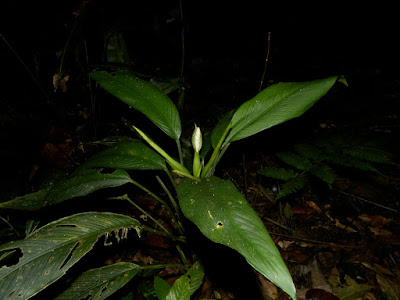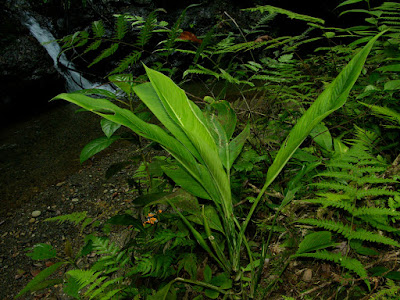Dieffenbachia burgeri is endemic to southwestern Costa Rica on the Pacific slope from Dominical to the Osa Peninsula, sea level to 500 m, rarely 1000 m elevation, in Tropical wet forest, Premontane wet forest, and sometimes in Premontane rain forest life zones. It occurs in wet forests and swampy sites.
Dieffenbachia burgeri is a species of genus Dieffenbachia. This species was described by Thomas Bernard Croat & Michael Howard Grayum in 2004. The species is named in honor of William Burger of the Field Museum of Natural History, long-time expert on Costa Rican plants, who made the first collection of the species as well as most of the earliest collections during his expeditions to Costa Rica.
IDENTIFY DIEFFENBACHIA BURGERI
Dieffenbachia burgeri is endemic to southwestern Costa Rica on the Pacific slope from Dominical to the Osa Peninsula, sea level to 500 m, rarely 1000 m elevation, in Tropical wet forest, Premontane wet forest, and sometimes in Premontane rain forest life zones. It occurs in wet forests and swampy sites.
It is a herbaceous perennial grows 0.5-1 m tall. The leaves scattered along stem with areas exposed except near apex and are 25-40 cm long, 5-16 cm wide, solid dark green, matte to weakly glossy (sometimes variegated with pale mottling). The species is characterized by the petiole sheathed ⅓–⅔ of its length, with the sheath acute at the apex; and the usually matte, greenish-drying leaf blades with numerous primary lateral veins. The blades are quite variable, ranging from narrowly oblong-elliptic to ovate-elliptic, oblong lanceolate or narrowly elliptic.
The plants blooms in the late wet season to early dry season from November to March, and mature fruits have been seen from early April to early October. The spathe at anthesis as having a strong unpleasant aroma.
DIEFFENBACHIA BURGERI CARE AND CULTURE
Cultural information should only be used as a guide, and should be to be adapted to suit you. Your physical location; where you grow your plants, how much time you have to devote to their care, and many other factors, will need to be taken into account. Only then can you decide on the cultural methods that best suit you and your plants.
Light:
Dieffenbachia burgeri tolerates a wide range of light conditions. Preferred levels of 1000 to 2000 foot candles. They will grow in heavy shade and can be used in dark areas of the home, but growth will be slowed. Best growth is achieved in bright indirect light.
Insufficient light can cause the lower leaves fall off and plant becomes leggy. Leaf yellowing or discoloration caused by plant being in full sunlight.
Rotate the plant regularly to provide adequate light to all sides of the plant and prevent it from reaching toward the light on one side.
Temperature:
Best growth occurs between 65° and 75°F. The temperature should not drop below 50°F. The lower leaf drop because of sudden changes in temperature, or the plant is in a drafty location.
Humidity:
A relatively moist atmosphere results in vigorous growth, because its large leaves may dry up in a hot room. Maintain humidity by grouping plants or with a pebble tray.
Low humidity in the room can cause the leaves dry up. Position the plant away from radiators, group plants, use pebble trays
Substrate and growing media:
Dieffenbachia burgeri needs a loose, fertile, high organic medium. Many different mixes can be used. The plants can be grown in pure peat; peat and perlite (1:1), soil and peat (1:1); or soil, peat and perlite/vermiculite (1:1:1). The growing medium should have good water-holding capacity and be well drained.
Repotting:
For smaller desktop plants, repotting once every 12-18 months with a potting vessel 1”- 2” larger in diameter to allow for growth. For larger floor plants, repotting every 18-24 months with a potting vessel 2”- 4” larger in diameter to allow for growth.
Don’t choose a pot much larger than the previous as this could drown the plant's roots. If you prefer to maintain the current size of your plant, repot into the same vessel, providing new soil and trimming away some roots and foliage. Spring or summer is the ideal time to repot as the plant is at its strongest.
Watering:
Maintain moderately moist soil. Watering is an important part of growing this plant. Water thoroughly and then not again until the surface of the potting medium is dry to the touch. Plants can be rooted and grown in water. Plants grown in soil should not be water logged; the plant will not tolerate constant overwatering. Overwatering cause yellowing and dropping off of lower leaves, plant rots off at the base.
Fertilizer:
The plant given a minimal amount of nutrients will grow slowly and retain a desired shape. If the plants are growing in limited light, they require less frequent fertilization. As a general guide, you can use a complete fertilizer such as 20-20-20 and feed every 4-6 weeks only during the active growing season.
Brown leaf edges and/or leaf tips, tip burn because of too much fertilizer or too dry for short periods. If there are excessive fertilizer salts in the soil, these salts will be in solution in this water droplet. When the droplets evaporate, the salts remain on the tip of the leaf and cause tip burn.
Pests and diseases:
Bacterial Rot/ Blight - a bacterial pathogen that causes soft rot. Ants can cause considerable damage because they carry certain aphids, which in turn secrete a honeydew. The ants gather and feed on this honeydew. Fungus may develop.
Mealybugs: The nymphs of this pest feed on the sap of the plant by piercing the outer layer of plant tissue and secrete the honeydew that is attractive to ants. Mealybugs can be controlled by wiping the area with a cotton ball dipped in rubbing alcohol.
Propagation:
New plants can be made from stem cuttings. Use tip cuttings from the terminal portion of the plant or from small shoots that develop from lateral buds. Be sure to avoid contact of the plant juice with skin.
Stems that have become bare from dropped leaves can be cut into 2” pieces (with at least one lateral bud). Dry the cuttings for a day, then stick them in a rooting medium such as peat, sand, perlite or vermiculite. Stem cuttings establish roots faster in sphagnum moss than in sand, and cuttings from the top of the plant root faster than sections taken from the base of the stem.
Larger stems initiate roots faster than smaller stems, apparently because the larger stems contain more stored food. Air layering can be used when the plant becomes top-heavy or lanky with naked stems.















COMMENTS